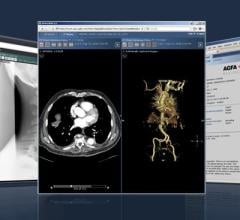
Image courtesy of Cerner
November 19, 2015 — MedCurrent Corp. will release MedCurrent CDS Version 3.0, a radiology decision support system designed to meet and exceed the requirements of the Centers for Medicare and Medicaid Services (CMS) mandate, at the Radiological Society of North America (RSNA) annual meeting in Chicago, Nov. 29-Dec. 3.
The newest version of the company’s clinical decision support (CDS) system streamlines efficiency for radiology departments and imaging centers. Updated interfaces are designed to enhance workflow while also improving physician adoption and compliance. MedCurrent CDS 3.0 provides significantly deeper data analytics functionality to measure the system’s effectiveness and drive improvement initiatives. Its updated Authoring Studio greatly simplifies the process of customizing rules to meet local medical practice patterns.
CDS software uses Appropriate Use Criteria (rule sets) to analyze and rank the appropriateness of a provider’s order for a diagnostic imaging exam. The software will then provide the provider with feedback as to whether they should consider ordering a more appropriate procedure, as well as additional information including the urgency of obtaining the study, how much radiation it will expose the patient to, how expensive it is and very importantly, whether it has already been performed recently. In addition to meeting the mandate, research has demonstrated the ability of CDS to reduce the number of inappropriate exams, thereby improving quality, reducing costs and reducing unnecessary exposure to radiation. Combined, these factors amount to an enhanced patient experience and improved clinical and operational efficiencies.
Many radiology departments receive a significant percentage of orders from outside their hospital electronic medical record/computerized physician order entry (EMR/CPOE) and therefore should factor in requirements such as integration with multiple disparate EMRs, CPOEs and scheduling systems. To ensure a localized CDS implementation, Stephen Herman, M.D., CEO of MedCurrent, elaborated that “a fully functional CDS system should include both tools to allow for rule localization to suit specific local practice patterns and the capacity to incorporate multiple rule sets for different ordering needs, such as lab, cardiology and oncology. This will set the stage for system evolution over time to achieve enterprise-wide operational efficiency.”
Research shows the effective use of a CDS will require significant cultural shifts among physicians who order imaging studies. “Systems that are easy for physicians to use will be the gold standard,” Herman said, noting that radiology clinical decision support is one of the solutions that will be most shopped at RSNA 2015.
New features of MedCurrent CDS 3.0 include:
- Improved interfaces that are clinically-intuitive and present relevant clinical information, such as duplicate procedures and patient history, at the time of order entry;
- A new platform that enables two-way communication with the EMR, CPOE, scheduling and other aligned systems;
- Cross-workflow compatibility to send orders through fax or email and capacity for modular integration into picture archiving and communication systems (PACS) and radiology information systems (RIS);
- A user-friendly authoring studio to tailor Appropriateness Use Criteria (a requirement to be recognized by the CMS as a Provider-Led Entity) and to integrate rule sets from multiple clinical specialties (lab, cardiology, etc.); and
- An enhanced, Web-based analytics platform to help guide behavior change and identify outliers with easy report generation, including peer-to-peer comparisons and trend evaluations in ordering appropriateness by provider, modality, etc.
For more information: www.medcurrent.com


 May 24, 2024
May 24, 2024 








